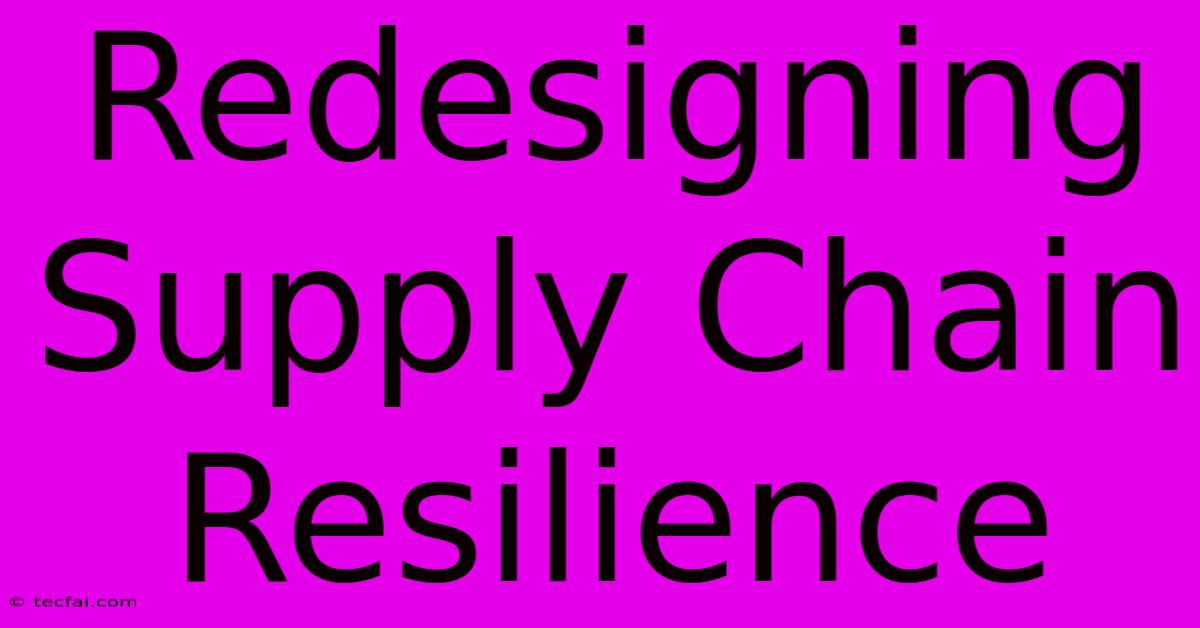Redesigning Supply Chain Resilience

Discover more detailed and exciting information on our website. Click the link below to start your adventure: Visit Best Website tecfai.com. Don't miss out!
Table of Contents
Redesigning Supply Chain Resilience: A Holistic Approach
The global landscape has shifted dramatically, exposing vulnerabilities in even the most robust supply chains. From geopolitical instability and pandemics to climate change and natural disasters, the need for resilient supply chains is no longer a suggestion, but a critical imperative for business survival and prosperity. This article explores the key elements of redesigning your supply chain for greater resilience, focusing on a holistic approach that goes beyond simple diversification.
Understanding the New Normal: Beyond Just Diversification
While diversifying sourcing and manufacturing locations remains crucial, it’s merely one piece of a much larger puzzle. True resilience requires a fundamental shift in thinking, moving from a reactive to a proactive approach. This involves anticipating disruptions, building flexibility into operations, and fostering strong relationships across the entire supply chain ecosystem.
Key Factors Contributing to Supply Chain Fragility:
- Geopolitical risks: International conflicts, trade wars, and political instability can severely impact logistics and access to raw materials.
- Pandemics and epidemics: The COVID-19 pandemic starkly revealed the interconnectedness of global supply chains and the devastating impact of widespread illness.
- Climate change and extreme weather events: More frequent and intense weather events disrupt transportation, damage infrastructure, and impact agricultural production.
- Cybersecurity threats: Attacks on IT systems can cripple operations, leading to production delays and significant financial losses.
- Lack of transparency and visibility: Limited real-time data and poor communication hamper effective risk management and response.
Building a Resilient Supply Chain: A Multi-faceted Approach
Redesigning your supply chain for resilience requires a holistic approach focusing on several key areas:
1. Enhanced Visibility and Data Analytics:
- Implement robust tracking and tracing systems: Real-time visibility into inventory levels, transportation status, and potential disruptions is paramount.
- Leverage data analytics: Use data-driven insights to identify vulnerabilities, predict potential risks, and optimize decision-making.
- Invest in advanced technologies: Blockchain technology, IoT sensors, and AI-powered predictive modeling can enhance transparency and improve forecasting accuracy.
2. Strategic Sourcing and Supplier Relationship Management:
- Diversify sourcing: Reduce reliance on single suppliers by establishing multiple sources for critical materials and components.
- Develop strong supplier relationships: Foster collaboration and trust with key suppliers to ensure reliable supply and timely communication.
- Onboard and vet suppliers rigorously: Ensure suppliers meet your quality, sustainability, and ethical standards.
- Consider nearshoring or reshoring: Evaluate the benefits of moving production closer to home to reduce transportation costs and risks.
3. Agile and Flexible Operations:
- Build flexible manufacturing processes: Design processes that can adapt quickly to changing demand and unexpected disruptions.
- Increase inventory buffer levels: Maintain strategic safety stock to mitigate the impact of unforeseen events.
- Invest in modular design: Develop products and components with interchangeable parts to facilitate repairs and reduce downtime.
4. Robust Risk Management and Contingency Planning:
- Develop a comprehensive risk assessment framework: Identify potential disruptions and their likely impact on your supply chain.
- Create detailed contingency plans: Outline specific actions to be taken in the event of various disruptions.
- Regularly test and update contingency plans: Ensure plans remain effective and relevant in a dynamic environment.
5. Strong Collaboration and Communication:
- Establish clear communication channels: Ensure effective information flow across the entire supply chain.
- Foster collaboration with partners: Work collaboratively with suppliers, logistics providers, and customers to mitigate risks and improve resilience.
- Invest in employee training: Equip your team with the skills and knowledge necessary to respond effectively to disruptions.
Conclusion: Embracing a Proactive Approach
Redesigning your supply chain for resilience is an ongoing process, not a one-time project. It requires a long-term commitment to investing in technology, building strong relationships, and embracing a culture of proactive risk management. By implementing these strategies, businesses can significantly enhance their ability to withstand disruptions, maintain operational continuity, and achieve sustainable growth in an increasingly uncertain world. The future belongs to those who proactively build resilience into their operations.

Thank you for visiting our website wich cover about Redesigning Supply Chain Resilience. We hope the information provided has been useful to you. Feel free to contact us if you have any questions or need further assistance. See you next time and dont miss to bookmark.
Featured Posts
-
Ronaldo Red Al Nassr Se Titel Streeftog
Nov 30, 2024
-
Zach Bryan Two Dublin Phoenix Park Shows
Nov 30, 2024
-
Mamelodi Sundowns Caf Match Highlights
Nov 30, 2024
-
Gatland Faces Wales Criticism Too Pointed
Nov 30, 2024
-
Larkfield St Andrews Day History
Nov 30, 2024
